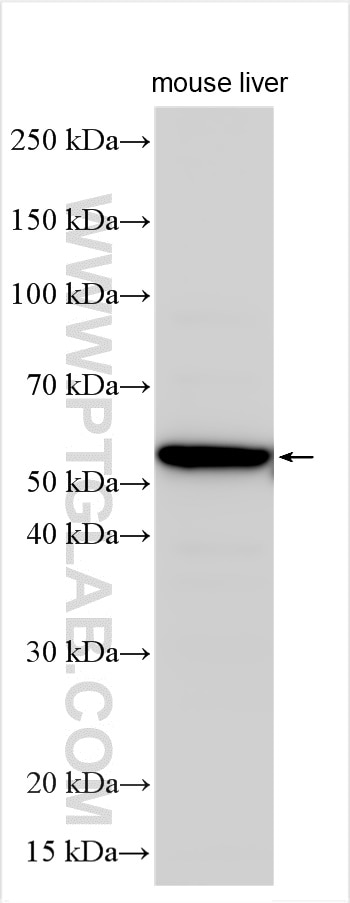Tested Applications
| Positive WB detected in | mouse liver tissue |
Recommended dilution
| Application | Dilution |
|---|---|
| Western Blot (WB) | WB : 1:1000-1:8000 |
| It is recommended that this reagent should be titrated in each testing system to obtain optimal results. | |
| Sample-dependent, Check data in validation data gallery. | |
Product Information
13826-1-AP targets CYP4V2 in WB, ELISA applications and shows reactivity with human, mouse samples.
| Tested Reactivity | human, mouse |
| Host / Isotype | Rabbit / IgG |
| Class | Polyclonal |
| Type | Antibody |
| Immunogen | CYP4V2 fusion protein Ag4952 Predict reactive species |
| Full Name | cytochrome P450, family 4, subfamily V, polypeptide 2 |
| Calculated Molecular Weight | 61 kDa |
| Observed Molecular Weight | 55 kDa |
| GenBank Accession Number | BC060857 |
| Gene Symbol | CYP4V2 |
| Gene ID (NCBI) | 285440 |
| RRID | AB_3669171 |
| Conjugate | Unconjugated |
| Form | Liquid |
| Purification Method | Antigen affinity purification |
| UNIPROT ID | Q6ZWL3 |
| Storage Buffer | PBS with 0.02% sodium azide and 50% glycerol , pH 7.3 |
| Storage Conditions | Store at -20°C. Stable for one year after shipment. Aliquoting is unnecessary for -20oC storage. 20ul sizes contain 0.1% BSA. |
Background Information
A cytochrome P450 monooxygenase involved in fatty acid metabolism in the eye. Catalyzes the omega-hydroxylation of polyunsaturated fatty acids (PUFAs) docosahexaenoate (DHA) and its precursor eicosapentaenoate (EPA), and may contribute to the homeostasis of these retinal PUFAs (PMID: 22772592).
Protocols
| Product Specific Protocols | |
|---|---|
| WB protocol for CYP4V2 antibody 13826-1-AP | Download protocol |
| Standard Protocols | |
|---|---|
| Click here to view our Standard Protocols |



